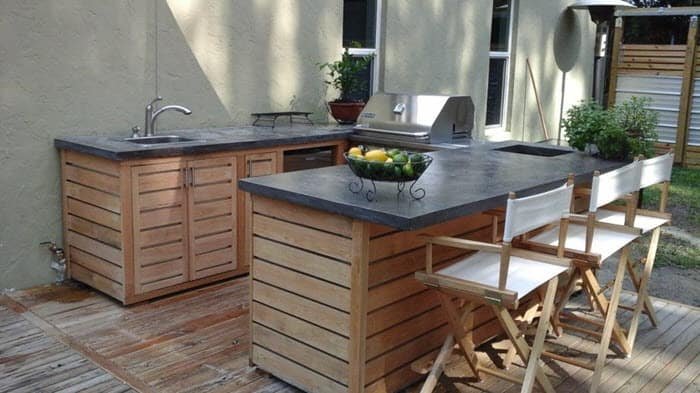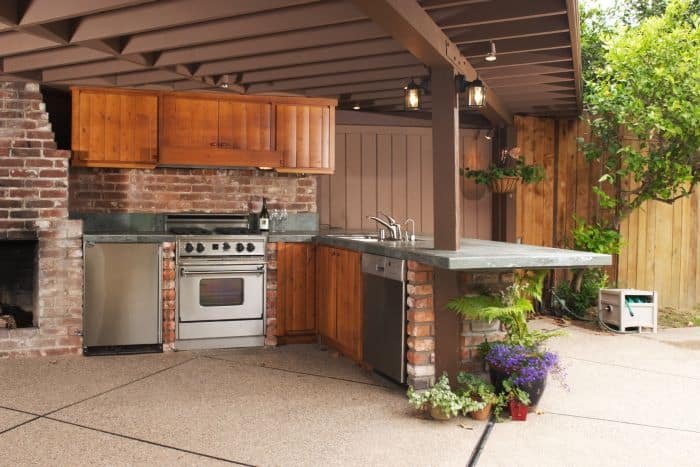How to Drain Outdoor Kitchen Sink

An outdoor sink is useful for so many reasons. Washing your hands after digging in the dirt, washing dirt off hand tools, rinsing meat or veggies before grilling, etc.
No matter if you just have a sink table or a full size outdoor kitchen, you should plan on how to drain your outdoor sink. Local building codes will dictate which method you can or can not use and should always be consulted before moving forward with your outdoor kitchen project.
If you want an outdoor kitchen sink, you need to be able to drain it. There are several different ways to drain an outdoor sink.
The three ways to drain an outdoor kitchen sink is an under-sink bucket, a french drain/dry well or connecting it to your house drainage system.
How you use your outdoor kitchen sink will be the biggest determination on the best way to drain it. Let’s discuss the pros and cons of each way to drain an outdoor sink to determine which is right in your backyard.
Table of Contents
Under-Sink Bucket
Using an under the sink bucket is the easiest way to drain an outdoor sink. Install your sink with a simple straight tailpipe that is long enough to fit just inside a container, such as a 5-ballon bucket.
With this method you simply need to empty the bucket before it overflows. You’ll want to empty the bucket before it gets too full since a full bucket of water weighs 40 lbs. and will slosh everywhere.
| Pros | Cons |
|---|---|
| Easy installation | Have to dump bucket every time |
| No Repairs or Clean Out necessary | Bucket can be heavy |
| Can drain anything down sink |
French Drain & Dry Well
If you don’t want to heft a bucket around every time you use your outdoor kitchen sink, consider installing a french drain into a dry well. This is the method I have used on two different outdoor kitchen set-ups. It’s a simple set-up and cheaper than connecting your sink to your current drainage system.
Installing this method can be simple depending on where your dry well will be located in relation to your sink.
How much you use your outdoor kitchen sink will determine the dry well location. If it is used heavily, you’ll need a location that is away from your house or deck foundation. If you use the sink sparingly, the dry well can be located closer to your sink.
A simple dry well can be a buried bucket that is filled with smaller rocks and has gravel all around and underneath the bucket. Run plumbing lines from your sink to this dry well.
| Pros | Cons |
|---|---|
| Easy installation | Can get clogged if draining animal fats or oil |
| Cheaper than tying into sewer system | Difficult to dig hole if soil is frozen or hard |
| Use sink as normal with caveats |
Connecting to the Closest Drain Line
This the best method to drain your outdoor kitchen sink if you plan on using it like an indoor sink. The cost will depend on how far away your current drainage system is located from the outdoor sink, but is more expensive than the other two options.
If you have a full outdoor kitchen including other appliances like a dishwasher, you may be required by code to connect your outdoor sink to your current drainage system. Check with your local building department.
| Pros | Cons |
|---|---|
| Use sink as normal | More expensive than other two options |
| No extra digging for dry well | |
| No bucket to haul away every day |
FAQ
How do I run water to my outdoor kitchen sink?
Most people connect an outdoor faucet to their sink and only have cold water. But, if you want hot and cold, you will have to run additional water lines from current house plumbing. You might also need a point of use tankless hot water heater.
Can sink drain in exterior wall?
Yes, but if you live in a cold area that freezes, you will need to insulate your drain pipe very well. If you don’t, it may freeze causing the pipe to crack and leak inside the wall.
How do I drain my outdoor sink for winter?
Shut off the water to the sink, then open the sink valves to drain the excess water from the pipes. Also, disconnect the p-trap and empty is it as well.
Can outdoor sink drain to the yard?
Yes, depending on local building codes and what you put down your sink. If you’re just rinsing dirt off hands or food, it should be fine. If you put chemicals down the drain or other non-natural substances, it should not be drained in your yard.
How do I find the outside drain pipe?
Typically an outdoor drain pipe will have a green or white cap sticking out of the ground somewhere along the perimeter of your house. If you can’t find it, call a plumber as they can find it for you.
How do I know if my outdoor drain is blocked?
If your sink isn’t draining, more than likely there is a blockage. Luckily since it’s outside, it should be easier to find the clog.
Try running a handheld drain snake through the pipe to break up the clog and if that doesn’t work, call a plumber.
Do I need a p-trap in an outdoor sink?
No, if using a bucket or french drain system. A p-trap is only used to prevent sewer smells from coming up the sink pipe. Use one if your outdoor sink is hooked up to sewer system.






We purposely built our outdoor counter so the sink would be directly over the clean out plug on the exterior wall of our home. It still retains the removable cap so the clean out function is still usable. We installed a P-trap under the sink.